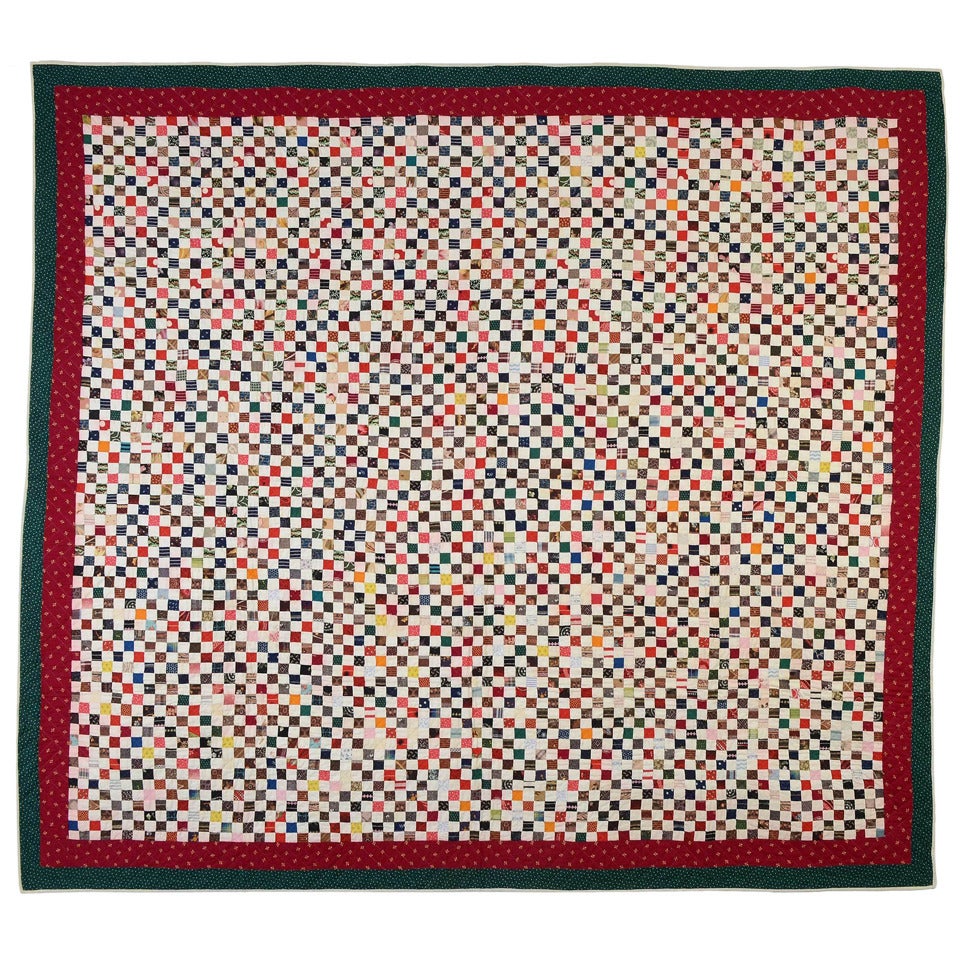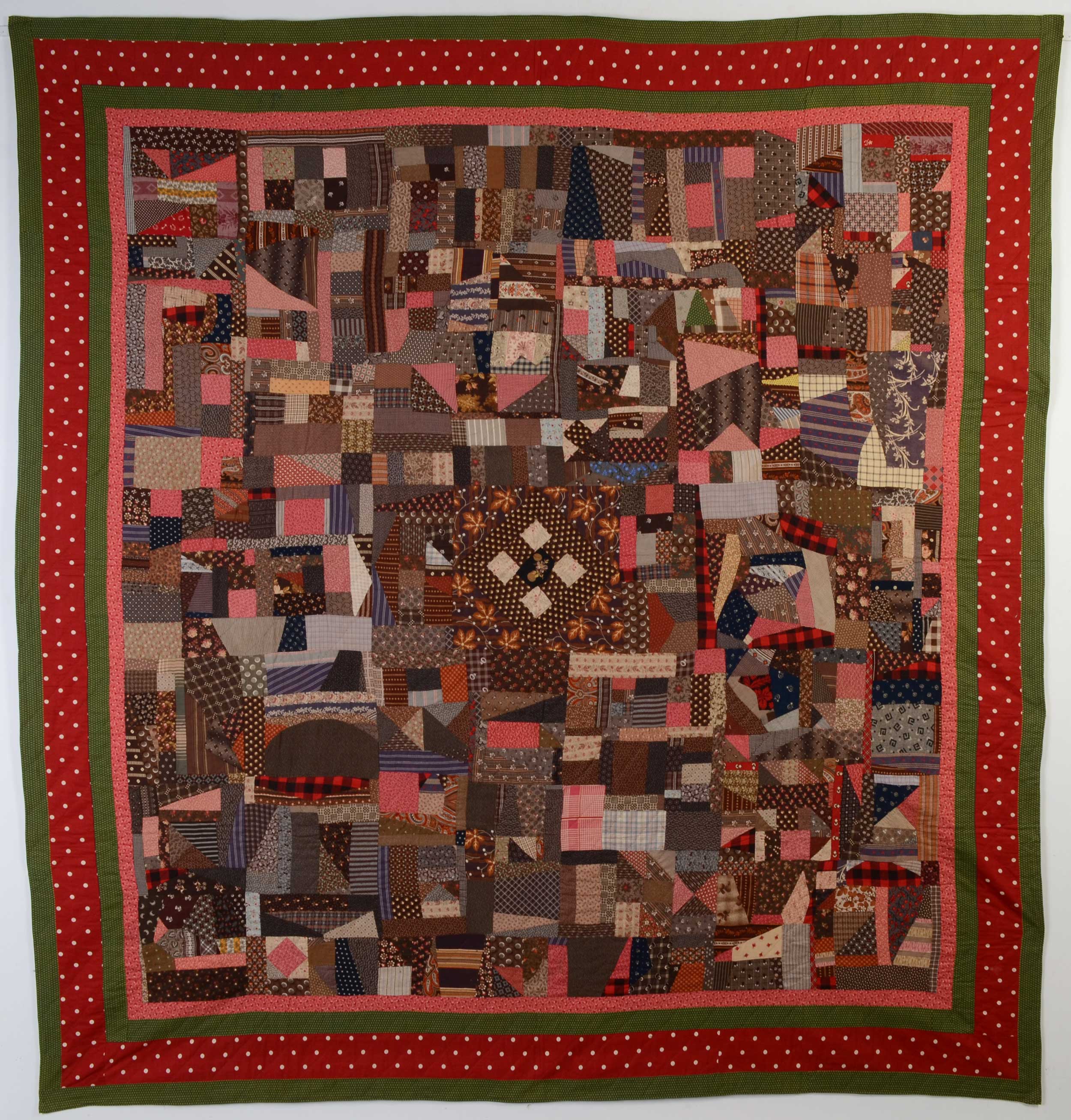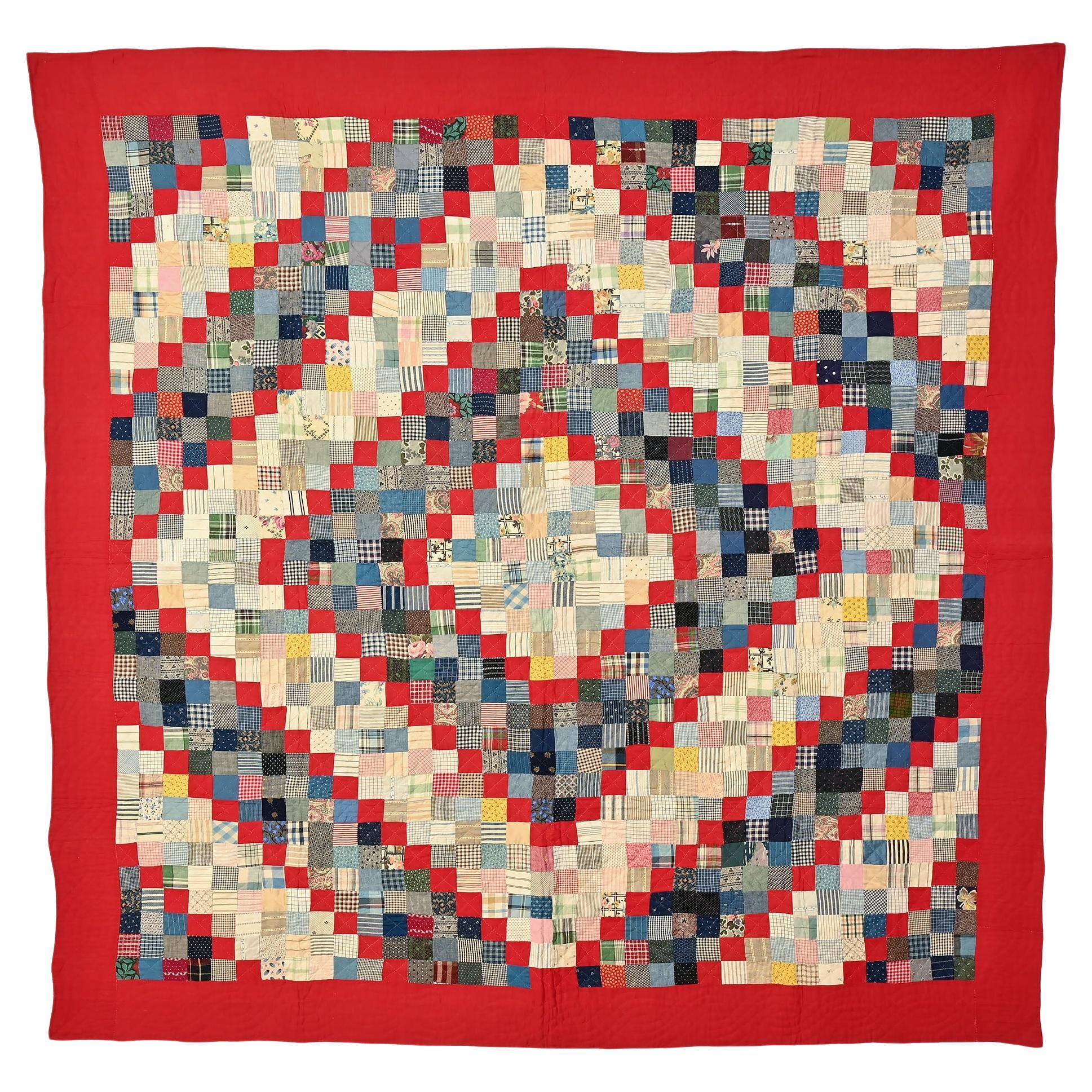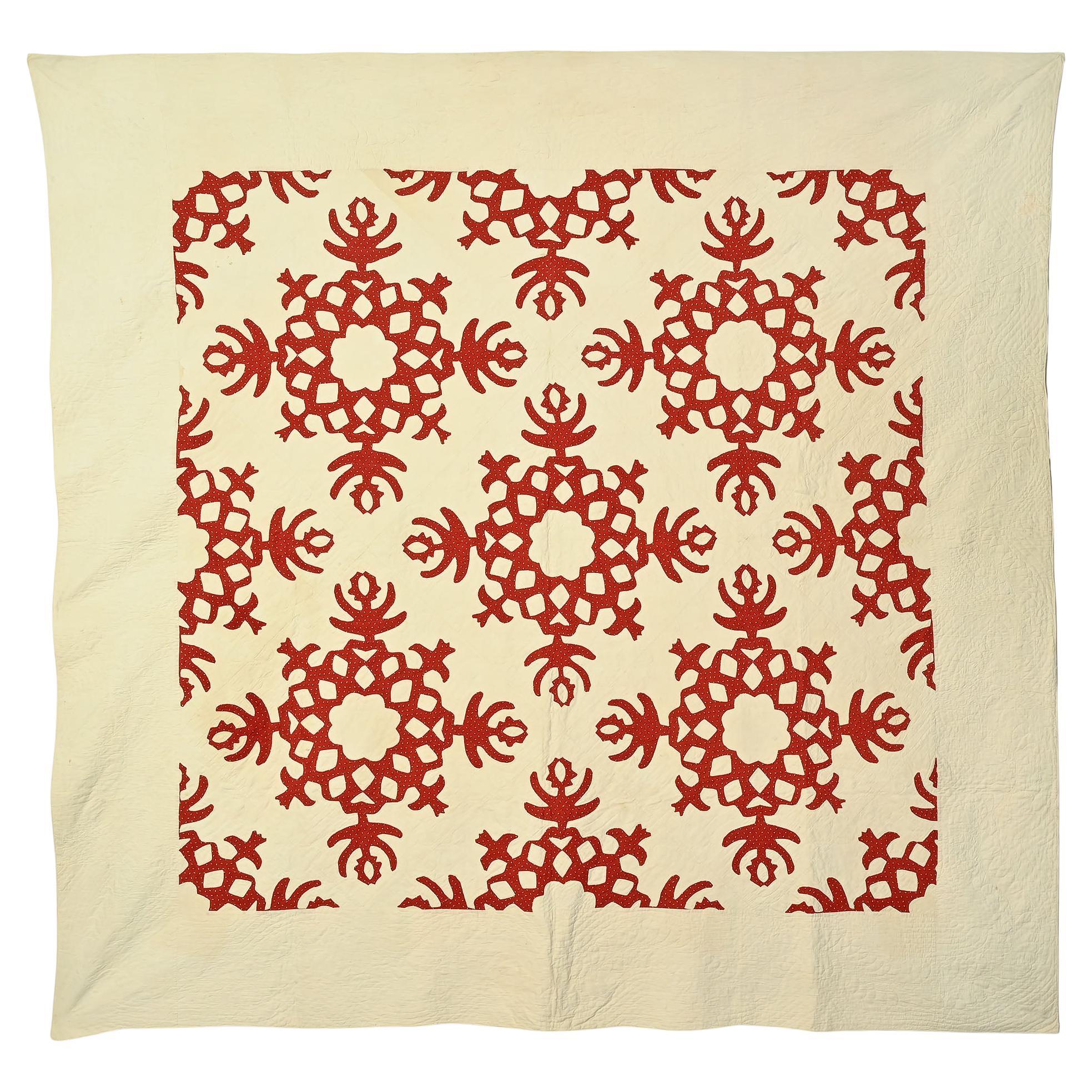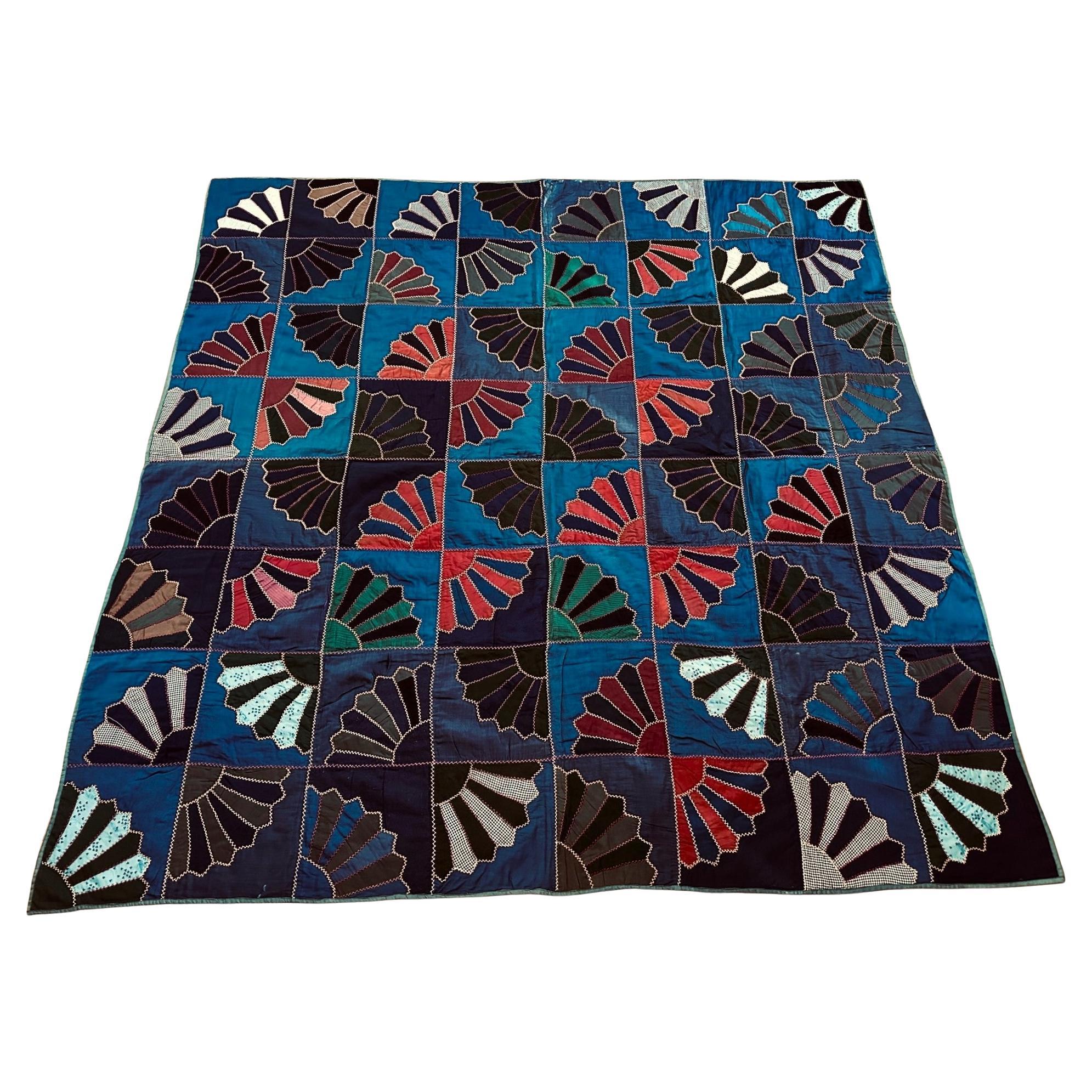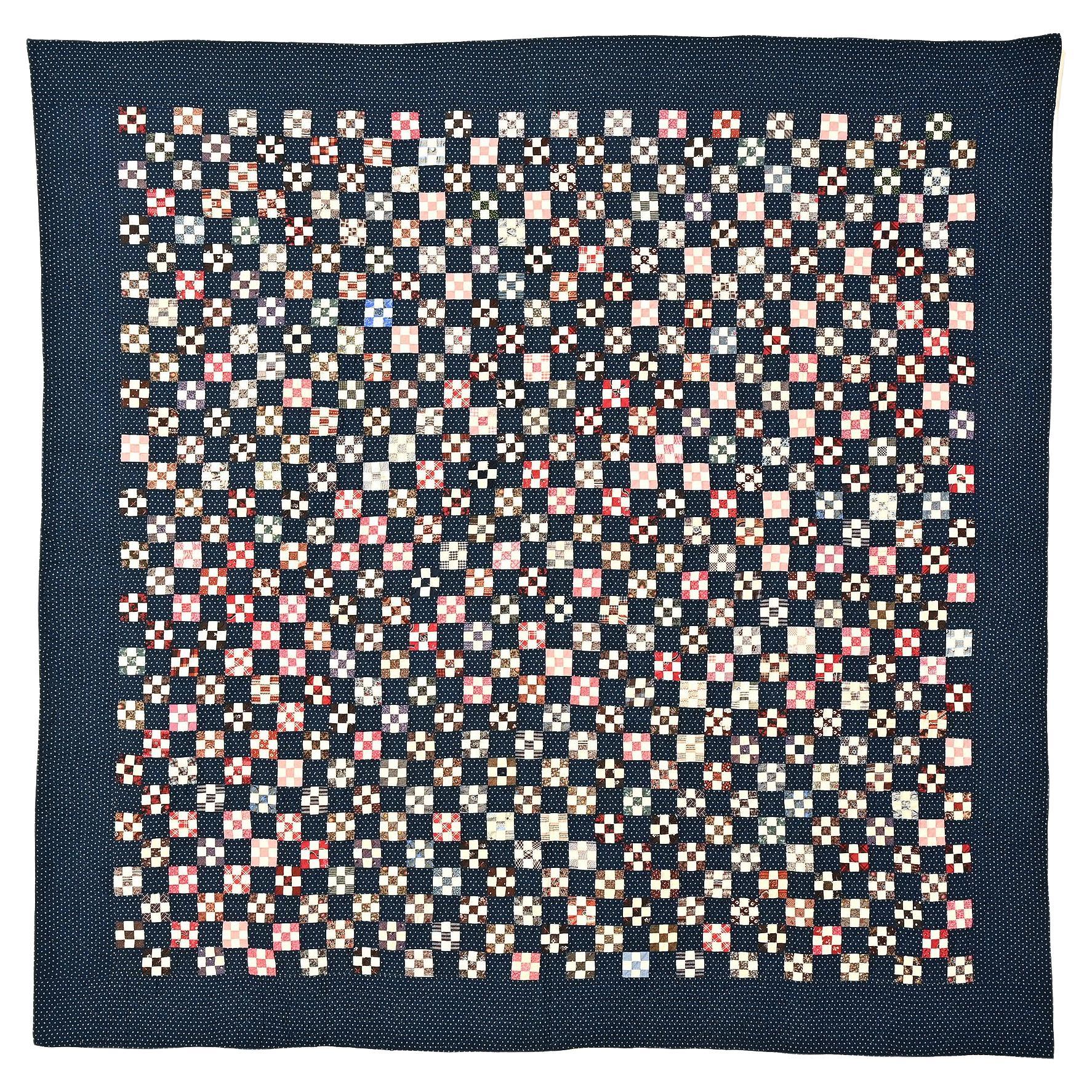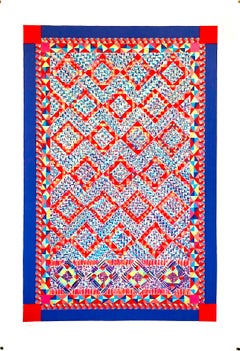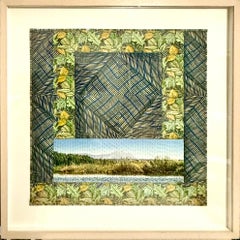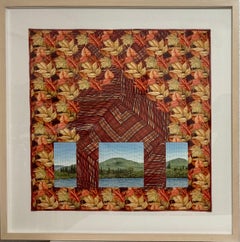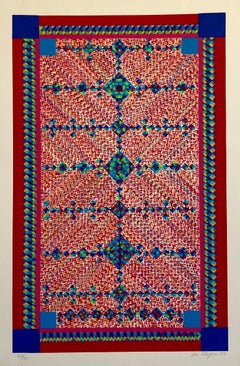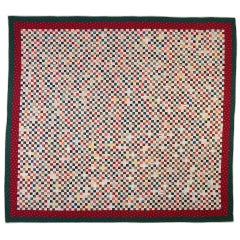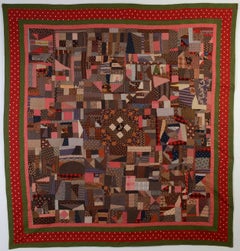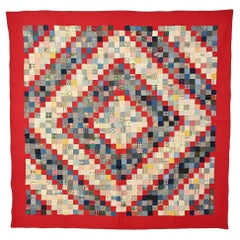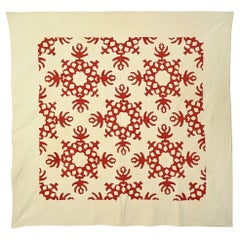Items Similar to Mixed Media Collage Feminist Lithograph Folk Art Quilt Pattern & Decoration Art
Want more images or videos?
Request additional images or videos from the seller
1 of 10
Barbara Kohl-SpiroMixed Media Collage Feminist Lithograph Folk Art Quilt Pattern & Decoration Art
$750
£572.86
€655.06
CA$1,066.17
A$1,169.33
CHF 611.53
MX$14,128.70
NOK 7,673
SEK 7,232.73
DKK 4,889.06
About the Item
Bow Tie
Hand signed and numbered, ,limited edition lithograph collage assemblage.
Barbara Kohl-Spiro is a Milwaukee, Wisconsin-based artist whose work has spanned over five decades and has been exhibited internationally. She works in collage, mixed media, watercolor painting and Jewish culture has a strong influence on Spiro’s work and is close to her heart.
Spiro is particularly interested in art made by common people of various cultures where the art is a reflection of their belief system. Spiro has exhibited in solo and group exhibitions, including at the Golda Meir Library, University of Wisconsin-Milwaukee; Portals Gallery, Chicago, Illinois; Kohler Art Museum, Sheboygan, Wisconsin; Michael Lord Gallery, Milwaukee, Wisconsin; and Albright-Knox Museum, Buffalo, New York. Barbara Kohl work was included in the Mishkenot Sha’ananim at the Israel Museum, Jerusalem, Israel (2003), 1994; Wisconsin Artists: A Celebration of Jewish Presence
2005 Strength-Four Strong Wisconsin Woman. Kohl-Spiro says that: "For me, my life has been dedicated to family, tradition, and adding to the big pot of culture that I have the freedom to do. I celebrate families, daughters, granddaughters, and the creative spirit." The geometric pattern of the quilt, has elements of the Op art of the 1960s, and of the Italian Memphis movement of the 1980s. Spiro is represented in the collection of the Albright-Knox Museum, Buffalo, New York; Syracuse University, Syracuse, New York; the Whitney Museum of Art, New York City; and the Bradley Collection, Milwaukee Art Museum, in Wisconsin." (from the publication "Art in Embassies Exhibition" for the United States embassy in Prague, Czech Republic which has featured some of her work) There are strong Feminist overtones to her work. This is based on a folk art, log cabin quilt theme and is influenced by the Pattern and Decoration movement.
- Creator:Barbara Kohl-Spiro (1940, American)
- Dimensions:Height: 12.21 in (31 cm)Width: 9.06 in (23 cm)
- Medium:
- Movement & Style:
- Period:
- Condition:
- Gallery Location:Surfside, FL
- Reference Number:1stDibs: LU38215891092
About the Seller
4.9
Platinum Seller
Premium sellers with a 4.7+ rating and 24-hour response times
Established in 1995
1stDibs seller since 2014
1,811 sales on 1stDibs
Typical response time: 1 hour
- ShippingRetrieving quote...Shipping from: Surfside, FL
- Return Policy
Authenticity Guarantee
In the unlikely event there’s an issue with an item’s authenticity, contact us within 1 year for a full refund. DetailsMoney-Back Guarantee
If your item is not as described, is damaged in transit, or does not arrive, contact us within 7 days for a full refund. Details24-Hour Cancellation
You have a 24-hour grace period in which to reconsider your purchase, with no questions asked.Vetted Professional Sellers
Our world-class sellers must adhere to strict standards for service and quality, maintaining the integrity of our listings.Price-Match Guarantee
If you find that a seller listed the same item for a lower price elsewhere, we’ll match it.Trusted Global Delivery
Our best-in-class carrier network provides specialized shipping options worldwide, including custom delivery.More From This Seller
View AllQuilt or Persian Rug Serigraph Pattern and Decoration Feminist Lithograph Print
By Dee Shapiro
Located in Surfside, FL
Dee Shapiro is a Contemporary American artist and writer associated with the Pattern and Decoration movement. I have seen this referred to as Hejaz.
Dee Shapiro was inspired to be an Artist in her early years of education. Dee's career started in the 1970s as a pattern painter with her works of art included in the Pattern and Decoration at P.S. 1
(other artists included Mary Grigoriadis, Valerie Jaudon, Joyce Kozloff, Robert Kushner, Kim MacConnel, Miriam Schapiro, Betty Woodman, Robert Zakanitch.)
She researched and explored the Fibonacci Progression in color on graph paper and also explored geometric complexity of architectural designs, leading her to create the small horizontal oil paintings of cities and landscapes. Dee Shapiro became a Yaddo fellow in 2017.
Dee Shapiro obtained her bachelor's degree in 1958 and Master of Science in 1960 from Queens College, City University of New York. Dee Shapiro is an artist that sees the subject on a large scale, but what she creates is on a diminutive scale. Shapiro's strength is the ability to give expressive power on canvas that makes her work seem larger than they are. Dee Shapiro has been a teacher, lecturer, and writer through career. "I have been concerned with women’s issues most of my life. I have worked to enhance the position of women in society through supporting the work of women artists. As a contributor to Heresies Magazine and a founder of a women’s cooperative gallery as well as developing a body of work that references women’s work and more currently focuses on female sexual imagery, I identify with feminist matters and affairs."
Group exhibitions
2018 The American Dream, Emden, Germany
Solo exhibitions
2016 Art 101, Brooklyn, NY
2015 Andre Zarre Gallery, NYC
2015 Five Points Gallery, Torrington, CT
2012, 2010, 2009 Andre Zarre Gallery, NYC
2010 Norfolk Library, Norfolk, CT
2009 George Billis Gallery
2006 Harrison Street Gallery, Frenchtown, NJ
2004 The Mercy Gallery. Loomis Chafee, Windsor, CT.
2004,2002, 1998 Andre Zarre Gallery, NY C, National Arts Club, NYC
2000 Principle Gallery, Alexandria, VA
1998 Nassau County Museum of Fine Art, Roslyn, NY
1997 Andre Zarre Gallery, NYC
1996 North Winds, Port Washington, NY
1994, Andre Zarre Gallery, NYC
1984 Ana Sklar Gallery, Miami, FL
1983 Andre Zarre Gallery, NYC
1982 Everson Museum, Syracuse, NY, Andre Zarre Gallery, NYC
1981 Dubins Gallery, Los Angeles, CA, Zenith Gallery, Pittsburgh, PA
1980, 1976 Andre Zarre Gallery, NYC
1979 Gallery 700, Milwaukee, WI Andre Zarre GalleryNYC
1978 St. Mary's College, Notre Dame, IN
1977 University of Arkansas, Little Rock, AK
1975, 1973 Central Hall Gallery, Port Washington, NY, Nassau County Museum of Fine Art, Roslyn, NY
Selected bibliography
James Panero, Supreme Fiction The Hudson River School Revisited, March, 2010
Piri Halaz, From the Mayor’s Doorstep, April 2010
Steve Starger, Art New England, Dee Shapiro: “On The Horizontal,” Feb/Mar 2005
Maureen Mullarkey, The New York Sun,”The Last Time I Saw Cuba,” April 15, 2004
James Kalm, NY ARTS, International Edition, April 2000
Helen Harrison...
Category
1980s Abstract Geometric Abstract Prints
Materials
Screen
Textile Art Quilt Dye Painting Tapestry Mixed Media Gayle Fraas & Duncan Slade
Located in Surfside, FL
Gayle Fraas and Duncan Slade (American, 20th Century)
Mixed Technique Textile Art
Dye painted and printed on cotton fabric, machine and hand stitched, fused metal foil (gold leaf).
2002
'North Woods Suite'
This listing is for one piece. i am showing a picture of all 4 so you can see them. I currently have the 4 available.
Dimensions: 36.25 X 36.25 frame. Quilt is 28 X 28 inches
Float mounted behind acrylic in wood frames bearing Fraas / Slade studio labels verso
Collaborating artists Gayle Fraas and Duncan Slade's work has always explored the relationship of ornamental surface and portrayal of landscape in quest of a sense beyond place. Recognized for developing techniques for screen printing and painting with dye on fabric, other mediums include paint and ink on paper, metal, and wood. Their work sits at the junction of fine and applied arts with an influence of naive and folk art. Their collaborative dialogue has been continuous since the mid 1970’s. Fraas-Slade’s work has been selected for some of the defining exhibitions that have influenced the field of Art Quilts: “The New American Quilt”; originating at the Museum of Contemporary Crafts, New York City in 1976, (along with Helen Bitar, Katherine Westphal, Radka Donnell, Anne Raymo) “The Art Quilt” at the Los Angeles Municipal Museum in 1986 (including Nancy Crow, Jean Hewes, Terrie Mangat, Jan Myers-Newbury, Theresa May, Pamela Studstill and Pauline Burbidge) and “Six Continents of Quilts: the Permanent Collection of the Museum of Art and Design,” NYC, touring internationally from 2002-2005. (the show included Jenny Hearn, Anne Marie Kenny, Gayle Fraas and Duncan Slade, Susan Denton, Sanae Hattori, Joan Schultze, Jenny Hearn and Mary Baxter). Books where work is featured include : Paintings of Maine by Carl Little, American Quilts: the Democratic Art 1780-2007 by Robert Shaw, The Art Quilt by Robert Shaw, Quilts Today by Robert Shaw, The Art Quilt by Penny McMorris and Michael Kile and Art to Wear by Julie Schafler Dale. Fraas and Slade continue to teach and lecture on their work. Workshops have been taught at conferences, art centers and colleges including: Haystack Mt. School of Crafts, ME, Arrowmont School of Crafts, TN and the School of Visual Arts, NYC. In 1989 and 2003, the artist team received Maine Visual Artist Fellowships and in 1995 a National Endowment for the Arts/ New England Foundation Visual Artist Fellowship.
Collections include the Philadelphia Museum, Baltimore Museum, MD, Peabody Essex Museum, Museum of Art and Design, NYC., the International Quilt Study Center at the University of Nebraska and the corporate collections of Fidelity Investments, Nuveen, IL., Hilton Corporation and Elmira College. Public collections in Maine include Portland Public Library, Department of Transportation, Department of Marine Resources and the University of Maine/Orono. In 1989 and 2003 the artist team received Maine Visual Artist Fellowships and in 1995 a National Endowment for the Arts/ New England Foundation Visual Artist Fellowship. There has been a huge surge of interest in textile and tapestry art led by Anni Albers, Sheila Hicks, El Anatsui, Judith Scott, Nick Cave, Tanya Aguiñiga, Faith Ringgold and Olga de Amaral. More museums are showing and collecting this work.
Selected Solo Exhibitions
2018 - Silo Gallery, Nantucket Island School of Design and the Arts
2011 - Silo Gallery, Nantucket Island School of Design and the Arts
2010 - New Work, Silo Gallery, Nantucket Island School of Design and the Arts,
2009 - Island Images, Silo Gallery, Nantucket Island School of Design and the Arts, Nantucket, MA.
2007 - Watermarks, James Patrick Gallery, Wiscasset, ME; Frankie Weems Gallery, Meredith College, Raleigh, NC. Along the Coast, Maine Fiberarts Gallery, Topsham, ME
Varieties of Disturbance. Susan Maasch Fine Art, Portland, ME
2005 - Nauticals, Gleason Gallery, Boothbay Harbor, ME
2003 - New Work, Winfisky Gallery, Salem State College, Salem, MA
2001 - New Work, Works Gallery, Philadelphia, PA.
Selected Group Exhibitions
2020 - Maine Quilts: 250 Years of Community, Maine State Museum
2016 - Museum Collection: New Arrivals, Baltimore Museum of Art, Berman Gallery
2015 - Shared Sensibilities: The Piano Roll Project, Bates Mill Complex, Lewiston, ME
2014 - Masters: Contemporary Fiber Art, Maine Fiberarts Gallery, “Masters: Contemporary Fiber Art,” May - June
2013 - Layers: The John Walsh II Collection, Arnot Museum, Elmira College
2012 - Man-Made Quilts, Shelburne Museum, Shelburne, VT
Tribute to Ardis, University of Nebraska, Lincoln, International Quilt Study Center/Museum
2011 - Instruct, The Studios at Key West
Artpark 1974-1984, University of Buffalo Center for the Arts,
2009 - Reservoir, the John M. Walsh Collection, San Jose Museum of Quilts, San Jose, CA
2008 - Visual Systems, University of Nebraska, Lincoln, Howard Gallery
2005 - Rooted in Tradition, Foothills Art Center, Golden, CO
2004 - Envision 20/20, Colby College Museum of Art
Another Layer, Portland Museum of Art
2002 - The Portland Show, Greenhut Galleries
Six Continents of Quilts, Museum of Art and Design, NYC, traveling to: National Museum of Fine Arts, Taiwan Kaohsiung Museum of Fine Arts, Taiwan
Selected Collections
Elmira College, Cowles Hall, commissioned by John Walsh III 2017
Philadelphia Museum, Philadelphia, PA
Museum of Art and Design, NYC
Baltimore Museum of Art, Baltimore, MD
Peabody Essex Museum, Salem, MA.
Bowdoin College, Walker Art Museum, Brunswick, ME
John Nuveen Inc. Chicago, Ill., commissions 1985, 1994, 2000, 2001
University of Nebraska, Lincoln International Quilt Study Center, The James Collection
Rocky Mountain Quilt Museum, Golden, CO
Mass Mutual, Boston MA Waban, Inc. Boston, MA
University of Wisconsin, Madison, WI
Selected Awards and Fellowships
2012- The Studios at Key West, artist residency
2008, 2007 - Nantucket Island School of Design and the Arts. A.I.R. program
2007 - Robert M. MacNamara Foundation
2003, 1989 - Maine Visual Artist Fellowships
2004 - Maine Art Commission Good Idea Grant
Selected Biography
Art Quilts Unfolding: 50 Years of Innovation, Bavor, Ellis, Sielman, Sider – 10/2018
Artpark: 1974-1984, Sandra Firmin, University of Buffalo Art Galleries /Princeton Architectural 2010
Masters: Art Quilts Volume 2, Sterling Publications, 2011
American Quilts: The Democratic Art 1750-2007 by Robert Shaw- Sterling Press 2009
Paintings of Maine, by Carl Little and Arnold Skolnick, Downeast Press, 2006
Six Continents of Quilts, The Museum of Art and Design Collection, 2005
Contemporary Art Quilts...
Category
Early 2000s American Modern Mixed Media
Materials
Fabric, Thread, Paint, Mixed Media
Textile Art Quilt Dye Painting Tapestry Mixed Media Gayle Fraas & Duncan Slade
Located in Surfside, FL
Gayle Fraas and Duncan Slade (American, 20th Century)
Mixed Technique Textile Art
Dye painted and printed on cotton fabric, machine and hand stitched, fused metal foil (gold leaf).
2002
'North Woods Suite'
This listing is for one piece. i am showing a picture of all 4 so you can see them. I currently have the 4 available.
Dimensions: 36.25 X 36.25 frame. Quilt is 28 X 28 inches
Float mounted behind acrylic in wood frames bearing Fraas / Slade studio labels verso
Collaborating artists Gayle Fraas and Duncan Slade's work has always explored the relationship of ornamental surface and portrayal of landscape in quest of a sense beyond place. Recognized for developing techniques for screen printing and painting with dye on fabric, other mediums include paint and ink on paper, metal, and wood. Their work sits at the junction of fine and applied arts with an influence of naive and folk art. Their collaborative dialogue has been continuous since the mid 1970’s. Fraas-Slade’s work has been selected for some of the defining exhibitions that have influenced the field of Art Quilts: “The New American Quilt”; originating at the Museum of Contemporary Crafts, New York City in 1976, (along with Helen Bitar, Katherine Westphal, Radka Donnell, Anne Raymo) “The Art Quilt” at the Los Angeles Municipal Museum in 1986 (including Nancy Crow, Jean Hewes, Terrie Mangat, Jan Myers-Newbury, Theresa May, Pamela Studstill and Pauline Burbidge) and “Six Continents of Quilts: the Permanent Collection of the Museum of Art and Design,” NYC, touring internationally from 2002-2005. (the show included Jenny Hearn, Anne Marie Kenny, Gayle Fraas and Duncan Slade, Susan Denton, Sanae Hattori, Joan Schultze, Jenny Hearn and Mary Baxter). Books where work is featured include : Paintings of Maine by Carl Little, American Quilts: the Democratic Art 1780-2007 by Robert Shaw, The Art Quilt by Robert Shaw, Quilts Today by Robert Shaw, The Art Quilt by Penny McMorris and Michael Kile and Art to Wear by Julie Schafler Dale. Fraas and Slade continue to teach and lecture on their work. Workshops have been taught at conferences, art centers and colleges including: Haystack Mt. School of Crafts, ME, Arrowmont School of Crafts, TN and the School of Visual Arts, NYC. In 1989 and 2003, the artist team received Maine Visual Artist Fellowships and in 1995 a National Endowment for the Arts/ New England Foundation Visual Artist Fellowship.
Collections include the Philadelphia Museum, Baltimore Museum, MD, Peabody Essex Museum, Museum of Art and Design, NYC., the International Quilt Study Center at the University of Nebraska and the corporate collections of Fidelity Investments, Nuveen, IL., Hilton Corporation and Elmira College. Public collections in Maine include Portland Public Library, Department of Transportation, Department of Marine Resources and the University of Maine/Orono. In 1989 and 2003 the artist team received Maine Visual Artist Fellowships and in 1995 a National Endowment for the Arts/ New England Foundation Visual Artist Fellowship. There has been a huge surge of interest in textile and tapestry art led by Anni Albers, Sheila Hicks, El Anatsui, Judith Scott, Nick Cave, Tanya Aguiñiga, Faith Ringgold and Olga de Amaral. More museums are showing and collecting this work.
Selected Solo Exhibitions
2018 - Silo Gallery, Nantucket Island School of Design and the Arts
2011 - Silo Gallery, Nantucket Island School of Design and the Arts
2010 - New Work, Silo Gallery, Nantucket Island School of Design and the Arts,
2009 - Island Images, Silo Gallery, Nantucket Island School of Design and the Arts, Nantucket, MA.
2007 - Watermarks, James Patrick Gallery, Wiscasset, ME; Frankie Weems Gallery, Meredith College, Raleigh, NC. Along the Coast, Maine Fiberarts Gallery, Topsham, ME
Varieties of Disturbance. Susan Maasch Fine Art, Portland, ME
2005 - Nauticals, Gleason Gallery, Boothbay Harbor, ME
2003 - New Work, Winfisky Gallery, Salem State College, Salem, MA
2001 - New Work, Works Gallery, Philadelphia, PA.
Selected Group Exhibitions
2020 - Maine Quilts: 250 Years of Community, Maine State Museum
2016 - Museum Collection: New Arrivals, Baltimore Museum of Art, Berman Gallery
2015 - Shared Sensibilities: The Piano Roll Project, Bates Mill Complex, Lewiston, ME
2014 - Masters: Contemporary Fiber Art, Maine Fiberarts Gallery, “Masters: Contemporary Fiber Art,” May - June
2013 - Layers: The John Walsh II Collection, Arnot Museum, Elmira College
2012 - Man-Made Quilts, Shelburne Museum, Shelburne, VT
Tribute to Ardis, University of Nebraska, Lincoln, International Quilt Study Center/Museum
2011 - Instruct, The Studios at Key West
Artpark 1974-1984, University of Buffalo Center for the Arts,
2009 - Reservoir, the John M. Walsh Collection, San Jose Museum of Quilts, San Jose, CA
2008 - Visual Systems, University of Nebraska, Lincoln, Howard Gallery
2005 - Rooted in Tradition, Foothills Art Center, Golden, CO
2004 - Envision 20/20, Colby College Museum of Art
Another Layer, Portland Museum of Art
2002 - The Portland Show, Greenhut Galleries
Six Continents of Quilts, Museum of Art and Design, NYC, traveling to: National Museum of Fine Arts, Taiwan Kaohsiung Museum of Fine Arts, Taiwan
Selected Collections
Elmira College, Cowles Hall, commissioned by John Walsh III 2017
Philadelphia Museum, Philadelphia, PA
Museum of Art and Design, NYC
Baltimore Museum of Art, Baltimore, MD
Peabody Essex Museum, Salem, MA.
Bowdoin College, Walker Art Museum, Brunswick, ME
John Nuveen Inc. Chicago, Ill., commissions 1985, 1994, 2000, 2001
University of Nebraska, Lincoln International Quilt Study Center, The James Collection
Rocky Mountain Quilt Museum, Golden, CO
Mass Mutual, Boston MA Waban, Inc. Boston, MA
University of Wisconsin, Madison, WI
Selected Awards and Fellowships
2012- The Studios at Key West, artist residency
2008, 2007 - Nantucket Island School of Design and the Arts. A.I.R. program
2007 - Robert M. MacNamara Foundation
2003, 1989 - Maine Visual Artist Fellowships
2004 - Maine Art Commission Good Idea Grant
Selected Biography
Art Quilts Unfolding: 50 Years of Innovation, Bavor, Ellis, Sielman, Sider – 10/2018
Artpark: 1974-1984, Sandra Firmin, University of Buffalo Art Galleries /Princeton Architectural 2010
Masters: Art Quilts Volume 2, Sterling Publications, 2011
American Quilts: The Democratic Art 1750-2007 by Robert Shaw- Sterling Press 2009
Paintings of Maine, by Carl Little and Arnold Skolnick, Downeast Press, 2006
Six Continents of Quilts, The Museum of Art and Design Collection, 2005
Contemporary Art Quilts...
Category
Early 2000s American Modern Mixed Media
Materials
Fabric, Thread, Paint, Mixed Media
Quilt or Persian Rug Serigraph Pattern and Decoration Feminist Lithograph Print
By Dee Shapiro
Located in Surfside, FL
Dee Shapiro is a Contemporary American artist and writer associated with the Pattern and Decoration movement. I have seen this referred to as Hejaz.
Dee Shapiro was inspired to be an Artist in her early years of education. Dee's career started in the 1970s as a pattern painter with her works of art included in the Pattern and Decoration at P.S. 1
(other artists included Mary Grigoriadis, Valerie Jaudon, Joyce Kozloff, Robert Kushner, Kim MacConnel, Miriam Schapiro, Betty Woodman, Robert Zakanitch.)
She researched and explored the Fibonacci Progression in color on graph paper and also explored geometric complexity of architectural designs, leading her to create the small horizontal oil paintings of cities and landscapes. Dee Shapiro became a Yaddo fellow in 2017.
Dee Shapiro obtained her bachelor's degree in 1958 and Master of Science in 1960 from Queens College, City University of New York. Dee Shapiro is an artist that sees the subject on a large scale, but what she creates is on a diminutive scale. Shapiro's strength is the ability to give expressive power on canvas that makes her work seem larger than they are. Dee Shapiro has been a teacher, lecturer, and writer through career. "I have been concerned with women’s issues most of my life. I have worked to enhance the position of women in society through supporting the work of women artists. As a contributor to Heresies Magazine and a founder of a women’s cooperative gallery as well as developing a body of work that references women’s work and more currently focuses on female sexual imagery, I identify with feminist matters and affairs."
Group exhibitions
2018 The American Dream, Emden, Germany
Solo exhibitions
2016 Art 101, Brooklyn, NY
2015 Andre Zarre Gallery, NYC
2015 Five Points Gallery, Torrington, CT
2012, 2010, 2009 Andre Zarre Gallery, NYC
2010 Norfolk Library, Norfolk, CT
2009 George Billis Gallery
2006 Harrison Street Gallery, Frenchtown, NJ
2004 The Mercy Gallery. Loomis Chafee, Windsor, CT.
2004,2002, 1998 Andre Zarre Gallery, NY C, National Arts Club, NYC
2000 Principle Gallery, Alexandria, VA
1998 Nassau County Museum of Fine Art, Roslyn, NY
1997 Andre Zarre Gallery, NYC
1996 North Winds, Port Washington, NY
1994, Andre Zarre Gallery, NYC
1984 Ana Sklar Gallery, Miami, FL
1983 Andre Zarre Gallery, NYC
1982 Everson Museum, Syracuse, NY, Andre Zarre Gallery, NYC
1981 Dubins Gallery, Los Angeles, CA, Zenith Gallery, Pittsburgh, PA
1980, 1976 Andre Zarre Gallery, NYC
1979 Gallery 700, Milwaukee, WI Andre Zarre GalleryNYC
1978 St. Mary's College, Notre Dame, IN
1977 University of Arkansas, Little Rock, AK
1975, 1973 Central Hall Gallery, Port Washington, NY, Nassau County Museum of Fine Art, Roslyn, NY
Selected bibliography
James Panero, Supreme Fiction The Hudson River School Revisited, March, 2010
Piri Halaz, From the Mayor’s Doorstep, April 2010
Steve Starger, Art New England, Dee Shapiro: “On The Horizontal,” Feb/Mar 2005
Maureen Mullarkey, The New York Sun,”The Last Time I Saw Cuba,” April 15, 2004
James Kalm, NY ARTS, International Edition, April 2000
Helen Harrison...
Category
1980s Abstract Geometric Abstract Prints
Materials
Screen
Large Americana Folk Art Pictorial Hooked Rug Wool Wall Hanging Tapestry
By Trudi Shippenberg
Located in Surfside, FL
"RFD Courant",
hooked rug tapestry, rural community with country homes and buildings throughout rolling hills, lush green trees with three-dimensional leaves frame the scene, in the...
Category
20th Century Folk Art Mixed Media
Materials
Fabric, Wool
Textile Art Quilt Dye Painting Tapestry Mixed Media Gayle Fraas & Duncan Slade
Located in Surfside, FL
Gayle Fraas and Duncan Slade (American, 20th Century)
Mixed Technique Textile Art
Dye painted and printed on cotton fabric, machine and hand stitched, fused metal foil (gold leaf).
2002
'North Woods Suite'
This listing is for one piece. i am showing a picture of all 4 so you can see them. I currently have the 4 available.
Dimensions: 36.25 X 36.25 frame. Quilt is 28 X 28 inches
Float mounted behind acrylic in wood frames bearing Fraas / Slade studio labels verso
Collaborating artists Gayle Fraas and Duncan Slade's work has always explored the relationship of ornamental surface and portrayal of landscape in quest of a sense beyond place. Recognized for developing techniques for screen printing and painting with dye on fabric, other mediums include paint and ink on paper, metal, and wood. Their work sits at the junction of fine and applied arts with an influence of naive and folk art. Their collaborative dialogue has been continuous since the mid 1970’s. Fraas-Slade’s work has been selected for some of the defining exhibitions that have influenced the field of Art Quilts: “The New American Quilt”; originating at the Museum of Contemporary Crafts, New York City in 1976, (along with Helen Bitar, Katherine Westphal, Radka Donnell, Anne Raymo) “The Art Quilt” at the Los Angeles Municipal Museum in 1986 (including Nancy Crow, Jean Hewes, Terrie Mangat, Jan Myers-Newbury, Theresa May, Pamela Studstill and Pauline Burbidge) and “Six Continents of Quilts: the Permanent Collection of the Museum of Art and Design,” NYC, touring internationally from 2002-2005. (the show included Jenny Hearn, Anne Marie Kenny, Gayle Fraas and Duncan Slade, Susan Denton, Sanae Hattori, Joan Schultze, Jenny Hearn and Mary Baxter). Books where work is featured include : Paintings of Maine by Carl Little, American Quilts: the Democratic Art 1780-2007 by Robert Shaw, The Art Quilt by Robert Shaw, Quilts Today by Robert Shaw, The Art Quilt by Penny McMorris and Michael Kile and Art to Wear by Julie Schafler Dale. Fraas and Slade continue to teach and lecture on their work. Workshops have been taught at conferences, art centers and colleges including: Haystack Mt. School of Crafts, ME, Arrowmont School of Crafts, TN and the School of Visual Arts, NYC. In 1989 and 2003, the artist team received Maine Visual Artist Fellowships and in 1995 a National Endowment for the Arts/ New England Foundation Visual Artist Fellowship.
Collections include the Philadelphia Museum, Baltimore Museum, MD, Peabody Essex Museum, Museum of Art and Design, NYC., the International Quilt Study Center at the University of Nebraska and the corporate collections of Fidelity Investments, Nuveen, IL., Hilton Corporation and Elmira College. Public collections in Maine include Portland Public Library, Department of Transportation, Department of Marine Resources and the University of Maine/Orono. In 1989 and 2003 the artist team received Maine Visual Artist Fellowships and in 1995 a National Endowment for the Arts/ New England Foundation Visual Artist Fellowship. There has been a huge surge of interest in textile and tapestry art led by Anni Albers, Sheila Hicks, El Anatsui, Judith Scott, Nick Cave, Tanya Aguiñiga, Faith Ringgold and Olga de Amaral. More museums are showing and collecting this work.
Selected Solo Exhibitions
2018 - Silo Gallery, Nantucket Island School of Design and the Arts
2011 - Silo Gallery, Nantucket Island School of Design and the Arts
2010 - New Work, Silo Gallery, Nantucket Island School of Design and the Arts,
2009 - Island Images, Silo Gallery, Nantucket Island School of Design and the Arts, Nantucket, MA.
2007 - Watermarks, James Patrick Gallery, Wiscasset, ME; Frankie Weems Gallery, Meredith College, Raleigh, NC. Along the Coast, Maine Fiberarts Gallery, Topsham, ME
Varieties of Disturbance. Susan Maasch Fine Art, Portland, ME
2005 - Nauticals, Gleason Gallery, Boothbay Harbor, ME
2003 - New Work, Winfisky Gallery, Salem State College, Salem, MA
2001 - New Work, Works Gallery, Philadelphia, PA.
Selected Group Exhibitions
2020 - Maine Quilts: 250 Years of Community, Maine State Museum
2016 - Museum Collection: New Arrivals, Baltimore Museum of Art, Berman Gallery
2015 - Shared Sensibilities: The Piano Roll Project, Bates Mill Complex, Lewiston, ME
2014 - Masters: Contemporary Fiber Art, Maine Fiberarts Gallery, “Masters: Contemporary Fiber Art,” May - June
2013 - Layers: The John Walsh II Collection, Arnot Museum, Elmira College
2012 - Man-Made Quilts, Shelburne Museum, Shelburne, VT
Tribute to Ardis, University of Nebraska, Lincoln, International Quilt Study Center/Museum
2011 - Instruct, The Studios at Key West
Artpark 1974-1984, University of Buffalo Center for the Arts,
2009 - Reservoir, the John M. Walsh Collection, San Jose Museum of Quilts, San Jose, CA
2008 - Visual Systems, University of Nebraska, Lincoln, Howard Gallery
2005 - Rooted in Tradition, Foothills Art Center, Golden, CO
2004 - Envision 20/20, Colby College Museum of Art
Another Layer, Portland Museum of Art
2002 - The Portland Show, Greenhut Galleries
Six Continents of Quilts, Museum of Art and Design, NYC, traveling to: National Museum of Fine Arts, Taiwan Kaohsiung Museum of Fine Arts, Taiwan
Selected Collections
Elmira College, Cowles Hall, commissioned by John Walsh III 2017
Philadelphia Museum, Philadelphia, PA
Museum of Art and Design, NYC
Baltimore Museum of Art, Baltimore, MD
Peabody Essex Museum, Salem, MA.
Bowdoin College, Walker Art Museum, Brunswick, ME
John Nuveen Inc. Chicago, Ill., commissions 1985, 1994, 2000, 2001
University of Nebraska, Lincoln International Quilt Study Center, The James Collection
Rocky Mountain Quilt Museum, Golden, CO
Mass Mutual, Boston MA Waban, Inc. Boston, MA
University of Wisconsin, Madison, WI
Selected Awards and Fellowships
2012- The Studios at Key West, artist residency
2008, 2007 - Nantucket Island School of Design and the Arts. A.I.R. program
2007 - Robert M. MacNamara Foundation
2003, 1989 - Maine Visual Artist Fellowships
2004 - Maine Art Commission Good Idea Grant
Selected Biography
Art Quilts Unfolding: 50 Years of Innovation, Bavor, Ellis, Sielman, Sider – 10/2018
Artpark: 1974-1984, Sandra Firmin, University of Buffalo Art Galleries /Princeton Architectural 2010
Masters: Art Quilts Volume 2, Sterling Publications, 2011
American Quilts: The Democratic Art 1750-2007 by Robert Shaw- Sterling Press 2009
Paintings of Maine, by Carl Little and Arnold Skolnick, Downeast Press, 2006
Six Continents of Quilts, The Museum of Art and Design Collection, 2005
Contemporary Art Quilts...
Category
Early 2000s American Modern Mixed Media
Materials
Fabric, Thread, Paint, Mixed Media
You May Also Like
Postage Stamp Quilt
Located in Darnestown, MD
Postage Stamp quilt with a wide variety of late 19th century fabrics. The two borders have the latest fabrics, dating to the date to 1880's or 90's...
Category
Antique 19th Century American Quilts
$1,450
Cotton Crazy Quilt
Located in Darnestown, MD
This Cotton Crazy Quilt is truly a collage of fabrics. The center has the structure of a Nine Patch within a Diamond in a Square. This unusual touch pulls ...
Category
Antique 19th Century American Quilts and Blankets
Materials
Cotton
$1,800
One Patch Barnraising Quilt
Located in Darnestown, MD
This Barnraising pattern quilt is made with One Patches rather than the usual Log Cabin strips. The sold reds against the printed fabrics make a very strong statement. The prints are...
Category
Antique Early 1900s American Country Quilts
Materials
Cotton
Shenandoah Valley Original Pattern Applique Quilt
Located in Darnestown, MD
To my knowledge, this applique quilt is an original pattern. It is well quilted and appliqued with reverse applique in every block. It is nicely balanced with five full blocks and pa...
Category
Antique 1870s American Country Quilts
Materials
Cotton
Antique Americana Quilt with Fan Motifs
Located in Atlanta, GA
An antique hand-made quilt circa 1890-1900s originated from Ohio. The quilt features a striking patched square pattern with fan motifs, all hand stitched with colorful cotton appliqu...
Category
Antique 1890s American American Classical Quilts
Materials
Wool, Cotton
Miniature Nine Patch Quilt
Located in Darnestown, MD
This Miniature Nine Patch quilt is one of the smallest in scale that I have seen. Each block measures less than 2 inches to a side. It is from the collection of the Packwood House Mu...
Category
Antique 1880s American Country Quilts
Materials
Cotton
